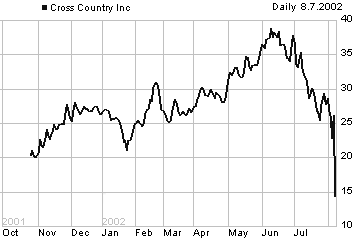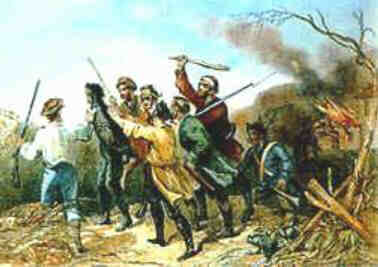Osama bin Laden's involvement.
At 10:30 a.m. local time, a massive truck bomb explodes outside the US embassy
in Nairobi, Kenya. Minutes later, another truck bomb detonated outside the
US embassy in Dar es Salaam, the capital of neighboring Tanzania. The dual
terrorist attacks killed 224 people, including 12 Americans, and wounded
more than 4,500. The United States accused Saudi exile Osama bin Laden,
a proponent of international terrorism against America, of masterminding
the bombings. On August 20, President Bill Clinton ordered cruise missiles
launched against bin Laden's terrorist training camps in Afghanistan and
against a pharmaceutical plant in Sudan, where bin Laden allegedly made
or distributed chemical weapons.
Osama
bin Laden was born in 1955 into one of Saudi Arabia's wealthiest and most
prominent families. His father, an immigrant from South Yemen, had built
a construction company into a multibillion-dollar company. When his father
died in 1968, bin Laden inherited an estimated $100 million but for the
next decade drifted without focus. In 1979, however, everything changed
when the Soviet Union invaded Afghanistan. Like tens of thousands of other
Arabs, bin Laden volunteered to aid Afghanistan in repulsing the godless
communist invaders of the Muslim country.
For the first few years of the Afghan War, he traveled around Saudi Arabia
and the Persian Gulf raising money for the anti-Soviet Afghan fighters.
In 1982, he traveled to the front lines of the war for the first time, where
he donated construction equipment for the war effort. Later, he personally
fought in a handful of skirmishes and battles. However, his primary role
in the anti-Soviet jihad was as financier. During the war, bin Laden made
contact with a number of Islamic militants, many of whom who were as anti-Western
as they were anti-Soviet.
In 1989,
the Soviets withdrew from Afghanistan, and bin Laden returned to Saudi Arabia.
He grew increasingly critical of the ruling Saudi family, especially after
hundreds of thousands of US troops were welcomed onto Saudi soil during
the Persian Gulf War. Although his passport was taken away, he managed to
escape Saudi Arabia in 1991 and settled in the Sudan. From there, he spoke
out against the Saudi government and the continuing US military presence
in Saudi Arabia, which he likened to the Soviet occupation of Afghanistan.
After the 1993 bombing of the World Trade Center in New York, the United
States began to suspect that bin Laden was involved in international terrorism
against the United States. The military organization he built during the
Afghan War — al-Qaeda, or "the base" — was still in existence,
and US intelligence believed he was transforming it into an anti-US terrorist
network.
In 1995, bin Laden called
for guerrilla attacks against US forces in Saudi Arabia, and three months
later a terrorist attack against a US military installation killed five
Americans. In June 1996, a truck bomb killed 19 US servicemen in Saudi Arabia.
Whether or not bin Laden was involved in planning these attacks has not
been established, but under US and Saudi pressure he was expelled from the
Sudan in 1996. With 200 of his followers, he returned to Afghanistan, which
was then falling under the control of the Taliban, a faction of extreme
Islamic fundamentalists. Soon after his arrival, bin Laden issued a fatwah,
or religious decree, calling for war on Americans in the Persian Gulf and
the overthrow of the Saudi government. In February 1998, he issued another
fatwah stating that Muslims should kill Americans, including civilians,
anywhere in the world.
On 07 August
1998 — the eighth anniversary of the deployment of US troops to Saudi
Arabia — two US embassies in East Africa are bombed almost simultaneously.
The attack at the Nairobi embassy, which was located in a busy downtown
area, caused the greater devastation and loss of life. There, a truck loaded
with one ton of TNT forced its way to the back entrance of the embassy and
was detonated, shattering the embassy, demolishing the nearby Ufundi Coop
House, and gutting the 17-story Cooperative Bank. By the time rescue operations
came to an end, 213 people were dead, including 12 from the US. Thousands
of people were wounded, and hundreds were maimed or blinded. The attack
against the US embassy in Dar es Saalam killed 11 and injured 85. By 1997,
US intelligence officers knew that bin Laden operatives were active in East
Africa but were unable to break up the terrorist cell before the embassies
were attacked. They had even heard of a possible plot to bomb the US embassy
in Nairobi but failed to recommend an increase in security before the attack.
Meanwhile, Prudence Bushnell, the US ambassador to Kenya, independently
asked the State Department to move the Nairobi embassy because of its exposed
location, but the request was not granted. Revelations of these pre-bombing
security issues provoked much controversy and concern about the United States'
vulnerability abroad.
Within days of
the 07 August bombings, two bin Laden associates would be arrested and charged
with the attacks. However, with bin Laden and other key suspects still at
large, President Clinton ordered a retaliatory military strike on 20 August.
In Afghanistan, some 70 US cruise missiles hit three alleged bin Laden training
camps. An estimated 24 persons were killed, but bin Laden was not present.
Thirteen cruise missiles hit a pharmaceutical plant in the Sudan, and the
night watchman was killed. The United States later backed away from its
contention that the pharmaceutical plant was making or distributing chemical
weapons for al-Qaeda.
In November 1998,
the United States indicted bin Laden and 21 others, charging them with bombing
the two US embassies and conspiring to commit other acts of terrorism against
Americans abroad. To date, nine of the al-Qaeda members named in the indictments
have been captured: Six are in the United States, and three are in Britain
fighting extradition to the United States. In February 2001, four of the
suspects went on trial in New York on 302 criminal counts stemming from
the embassy attacks. On 29 May all four were convicted on all counts. Saudi
citizen Mohamed Rashed Daoud al-'Owhali and Tanzanian Khalfan Khamis Mohamed
admitted to directly taking part in the terrorist attacks but claimed they
did not knowingly engage in a conspiracy against the United States. They
were both sentenced to life in prison without parole. Lebanese-born US citizen
Wadih El-Hage and Jordanian Mohammed Saddiq Odeh admitted ties to bin Laden
but denied involvement in any terrorist acts. They face a maximum sentence
of life in prison. Since June 1999, Osama bin Laden, the chief suspect in
the case, has been on the FBI's "Ten Most Wanted Fugitives" list, with a
$5 million award offered for information leading to his arrest. He is believed
to be in Afghanistan.
This is the eighth year anniversary of United Nations sanctions against
Iraq and the ordering of US troops into the Gulf region (operation Desert
Shield). Iraq informed the US Security Council that it was not going to
tolerate the continuation of the sanctions beyond the eighth year anniversary.
FOLLOW-UP
2000 Ali Mohamed, Egyptian-born
US citizen who served in the US Army, pleaded guilty in New York to helping
plan the US Embassy bombings.
Updated: Thu, Oct 18, 2001, 12:59 PM EDT
Four Osama bin Laden disciples convicted in the 1998 bombings of two US
embassies in Africa were sentenced to life without parole, on Thursday 18
October 2001 in a city still reeling from the 11 September 2001 terrorist
attacks. Khalfan Khamis Mohamed, 28, was the first to be sentenced at the
federal courthouse in lower Manhattan under heightened security. He and
Mohamed Rashed Al-'Owhali, 24, were sentenced for direct involvement in
the bombings. Mohamed Sadeek Odeh, 36, of Jordan, and Wadih El-Hage, 41,
were convicted of conspiracy and had been eligible for lesser sentences;
El-Hage, a former personal secretary to bin Laden, was the lone US citizen
convicted in the attacks. Judge Leonard B. Sand ordered each of the men
to pay $33 million in restitution: $7 million to the victims' families,
and $26 million to the US government. At a pre-sentencing hearing on Wednesday,
Sand said the defendants were indigent. But he also suggested that frozen
assets might be used for victims, thanks to recent attempts by the Bush
administration to choke off the funding of al-Qaida and other terror groups.
The near-simultaneous 07 August 1998,
bombings of the embassies in Kenya and Tanzania killed 231 people, including
12 Americans. They were quickly blamed on bin Laden, who was indicted in
the case, and his al-Qaida terrorist organization. El-Hage, described by
prosecutors as leading a double life where he raised both seven children
and money for bin Laden's network, condemned the Sept. 11 terrorist attacks
and the embassy bombings in a 30-minute address to the judge. "The killing
of innocent people is radical, extreme and cannot be tolerated by any religion,
principles or values," said El-Hage, a Lebanese-born naturalized American.
He repeatedly asserted his innocence, claiming he was a law-abiding American
and a devout Muslim opposed to violence. Odeh was described by defense lawyer
Ed Wilford as "a soldier in the military wing of al-Qaida." He said the
attack, in Odeh's view, was an attack against the US for its support of
Israel. Odeh criticized the Clinton administration on Thursday 18 October
2001 for its bombing of Afghanistan after the embassy attacks "I can only
say to Allah we belong, and to him we'll return," he said. "God help me
in my calamity, and replace it with goodness."
Mohamed, convicted of helping build the bomb that struck the embassy in
Dar es Salaam, Tanzania, declined to address the court. He and Al-'Owhali
had faced a possible death penalty in the case, but the jury could not agree
on that sentence. Through his attorney, Mohamed said he "wishes to express
gratitude to a jury that spared his life." "The jury has found you guilty
of crimes that mandate a life sentence, and I will of course impose a life
sentence," the judge told him. Al-'Owhali, who rode the bomb vehicle up
to the embassy in Nairobi, Kenya, and tossed stun grenades at guards before
fleeing, also declined to address the court. The four defendants' six-month
trial attracted little interest before the 11 September terrorist attacks
on the World Trade Center and the Pentagon, which killed more than 5'000
people. Security was tightened Thursday around the courthouse just blocks
from the trade center rubble. The courthouse is surrounded by steel barricades
to prevent possible attacks. The sentencing came after an appeal for life
sentences by the spouses of two people killed in the embassy bombings. "Let
them die conscious of the fact that their souls will be condemned forever,"
said Howard Kavaler, whose wife died in the attack on the Kenyan embassy.
Susan Hirsch, whose husband was killed in the bombing of the Tanzanian embassy,
said the defendants were giving the world a distorted view of the Islamic
religion. Her husband, Jamal, was Muslim. |
 On
an August 07:
On
an August 07:  1888
Theophilus Van Kannel of Philadelphia receives a patent for the
revolving door.
1888
Theophilus Van Kannel of Philadelphia receives a patent for the
revolving door.